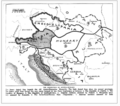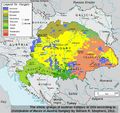Treaty of Trianon facts for kids
The Treaty of Trianon was a peace treaty signed in 1920. It was agreed upon by the Allied Powers of World War I and Hungary. This treaty officially ended the war between these groups.
Contents
What Was the Treaty of Trianon?
The Treaty of Trianon was a very important agreement made after World War I. It was signed on June 4, 1920, in a palace called Grand Trianon, near Paris, France. The main countries involved were the victorious Allies, like France, Britain, and Italy, and the defeated country, Hungary.
Why Was the Treaty Signed?
After World War I ended in 1918, the winning countries wanted to make sure that a big war like that wouldn't happen again. They also wanted to redraw the maps of Europe, especially for the countries that lost the war. Hungary was part of the Austro-Hungarian Empire, which was one of the losing sides. The Allies decided that Hungary needed to give up a lot of its land.
What Did Hungary Lose?
The Treaty of Trianon had huge effects on Hungary. It changed the country's size and its people's lives forever.
Land and People
Hungary lost a very large part of its territory. About two-thirds of its land was given to neighboring countries. These countries included Romania, Czechoslovakia, and Yugoslavia. This meant that many cities and towns that used to be in Hungary were now in other countries.
Because of these new borders, about one-third of the Hungarian-speaking population found themselves living outside of Hungary. This was a big change for many families and communities. It also led to a feeling called irredentism, which is when people want to get back land that they believe belongs to their country.
Money and Military
Besides losing land, Hungary also had to pay money to the winning countries. These payments were called World War I reparations. They were meant to help cover the costs and damages of the war.
The treaty also put limits on the size of Hungary's army. This was done to prevent Hungary from becoming a military threat again in the future.
What Was the Impact?
The Treaty of Trianon had a lasting impact on Hungary and the region. It created new borders and new nations, but it also left many Hungarians feeling like their country had been treated unfairly. This feeling continued for many years after the treaty was signed.
Images for kids
-
1885 ethnographic map of the Lands of the Crown of Saint Stephen, i.e. Kingdom of Hungary and Croatia-Slavonia according to the 1880 census
-
Hungary lost 72% of its territory, its sea access, half of its 10 biggest cities and all of its precious metal mines; 3,425,000 ethnic Hungarians found themselves separated from their motherland. Based on the 1910 Hungarian census with the Administrative Kingdom of Hungary in green and autonomous Croatia-Slavonia in grey
-
A statue of King Peter I, Karađorđević of Serbia at Freedom Square in Zrenjanin (Vojvodina, Serbia). The inscription on the monument says: "To the King Peter I, gratious people, to its liberator". Separation from the Kingdom of Hungary and unification with the Kingdom of Serbia was seen as an act of national liberation by the Vojvodinian Serbs.
See also
 In Spanish: Tratado de Trianón para niños
In Spanish: Tratado de Trianón para niños











